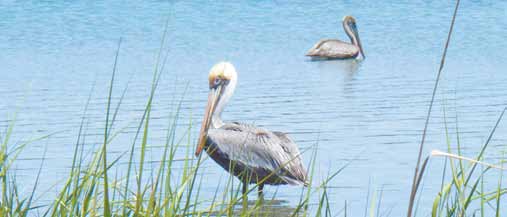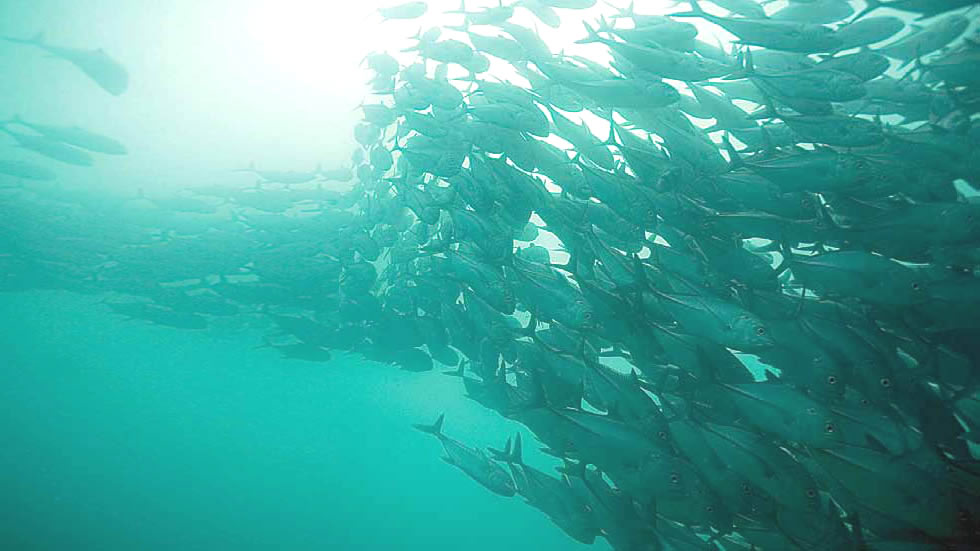 These pelicans find refuge in areas protected under the World Convention on Wetlands, of which Mexico is a signatory. (Photo: Juan José Cota)
These pelicans find refuge in areas protected under the World Convention on Wetlands, of which Mexico is a signatory. (Photo: Juan José Cota)San Ignacio, Baja California Sur – Sustainable development advocates from all over Mexico formed a common front when they celebrated the First Meeting of the Network for the Management and Conservation of Mexican Wetlands this past December 15-18.
“Fostering development needn't be based on the displacement of traditional activities nor on the uncontrolled extraction and monopolization of resources,” said the group in a collectively written national declaration at the conclusion of the event held at the Kadakaaman oasis.
The community groups in attendance further stated: “The natural resources belong to the people and are for their benefit. They must not be licensed to foreign concerns just out of a desire for progress, since the latter has already shown us that this approach has only generated poverty, social disintegration, and marginalized slum areas.”
The assembly was held to mark the 5th Meeting of Experiments in the Collective Management of Coastal Resources, with participation from nine States (Baja California, Baja California Sur, Chiapas, Nayarit, Oaxaca, Quintana Roo, Sonora, Veracruz and Yucatán), 29 agrarian organizations, the National Commission on Biodiversity (Conabio), the National Commission on Protected Natural Areas (Conanp), the Baja California Sur government, cooperatives, NGOs, and individuals committed to supporting Mexican ecosystems.
Groups participating from the Northeast included Pronatura, Cooperativa Única de Mujeres oyster farm, the ejidos(cooperatives) of Carlos Salinas de Gortari and Estación Doctor, the Intercultural Center for Desert and Oceanic Study (CEDO), and the Adair Bay Network of Wetland Collectives (REHBA).
The four days of meetings featured a Forum of National Pilot Programs, a fieldtrip, and discussions regarding global warming and food sovereignty.
Help Us Save the
Cabo Pulmo Coral Reef
¡CABO PULMO VIVO!
Help save the Gulf of California’s most important coral reef!
Sign the petition and volunteer here
What does this mean?
In simple terms, this decision means that the EIS authorization given to the Cabo Cortés project is null and void and that SEMARNAT’s Managing Director for Impact and Risk has to decide again if it will authorize the project, this time taking into account the objections that have been raised. Naturally, we will continue to look for every means possible to permanently block the authorization of of Cabo Cortés. What we have achieved so far is very encouraging.
Although this decision is great news to celebrate, it isn’t the end of the story. In the legal arena, there are still resources that SEMARNAT hasn’t responded to, and there is still much to do to stop
In the days and weeks to come, we will work to improve the laws as well as environmental planning instruments so that projects like these that are not sustainable and put the region’s natural capital at risk, can be avoided. Equally, we are working with East Cape communities to try to come up with a shared vision of the type of development that the region wants. We still have time to find a tourism development model that is orderly, that takes the environment into account and that brings economic growth and well-being to investors and community members alike.
 These pelicans find refuge in areas protected under the World Convention on Wetlands, of which Mexico is a signatory. (Photo: Juan José Cota)
These pelicans find refuge in areas protected under the World Convention on Wetlands, of which Mexico is a signatory. (Photo: Juan José Cota)The North Pacific Region will be coordinated by Raúl López Góngora from Baja California Sur and Carlos Daniel Soto from Sonora, the South Pacific Region by Agustín Reyes and Inti Escalona from Oaxaca, and the Gulf-Caribbean Region by Hermina Chávez from Veracruz and José Inés Loria from Yucatán.
“We called upon like-minded social organizations and commun-
ities to mobilize and get involved in defense of the natural and cultural heritage of the native people and their regions, and to strengthen communications and solidarity with other organ-
izations in Latin America and around the world,” they declared.
The meeting is a space created by civil society for the grass roots communities and organizations that collectively make use of coastal resources and ecosystems. The Southern Pacific Wetlands Program, from La Ventana, Oaxaca began the meetings in 2005. Later meetings were held in Chacahua, Oaxaca; Zacapulco, Chiapas; Alvarado, Veracruz; and San Blas, Nayarit.
The hosts of the fifth meeting were the Ejido Luís Echeverría, and the NGOs Comunidad Maijanu and the Forest Products Association of Mulegé.

Protected marine areas export marine resources to areas where they can be commercially exploited.